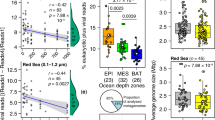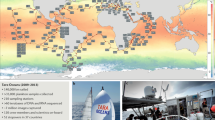Abstract
The oceans cover 70% of the planet’s surface, and their planktonic inhabitants generate about half the global primary production, thereby playing a key role in modulating planetary climate via the carbon cycle. The ocean biota have been under scientific scrutiny for well over a century, and yet our understanding of the processes driving natural selection in the pelagic environment – the open water inhabited by drifting plankton and free-swimming nekton – is still quite vague. Because of the fundamental differences in the physical environment, pelagic ecosystems function differently from the familiar terrestrial ecosystems of which we are a part. Natural selection creates biodiversity but understanding how this quality control of random mutations operates in the oceans − which traits are selected for under what circumstances and by which environmental factors, whether bottom-up or top-down − is currently a major challenge. Rapid advances in genomics are providing information, particularly in the prokaryotic realm, pertaining not only to the biodiversity inventory but also functional groups. This essay is dedicated to the poorly understood tribes of planktonic protists (unicellular eukaryotes) that feed the ocean’s animals and continue to run the elemental cycles of our planet. It is an attempt at developing a conceptually coherent framework to understand the course of evolution by natural selection in the plankton and contrast it with the better-known terrestrial realm. I argue that organism interactions, in particular co-evolution between predators and prey (the arms race), play a central role in driving evolution in the pelagic realm. Understanding the evolutionary forces shaping ocean biota is a prerequisite for harnessing plankton for human purposes and also for protecting the oceanic ecosystems currently under severe stress from anthropogenic pressures.




Similar content being viewed by others
References
Allen AE, Dupont CL, Oborník M, Horák A, Nunes-Nesi A, McCrow JP, Zheng H, Johnson DA, et al. 2011 Evolution and metabolic significance of the urea cycle in photosynthetic diatoms. Nature 473 203–208
Armbrust EV 2009 The life of diatoms in the world’s oceans. Nature 459 185–192
Assmy P and Smetacek V 2009 Algal blooms; in Encyclopedia of microbiology (ed) Moselio Schaechter (Oxford: Elsevier) pp 27–41
Assmy P, Henjes J, Klaas C and Smetacek V 2007 Mechanisms determining species dominance in a phytoplankton bloom induced by the iron fertilization experiment EisenEx in the Southern Ocean. Deep-Sea Res. I 54 340–362
Bagøien E and Kiørboe T 2005 Blind dating – mate finding in planktonic copepods. III. Hydromechanical communication in Acartia tonsa. Mar. Ecol. Prog. Ser. 300 129–133
Boyd PW, Jickells T, Law CS, Blain S, Boyle EA, Buesseler KO, Coale KH, Cullen JJ, et al. 2007 Mesoscale iron-enrichment experiments 1993-2005: synthesis and future directions. Science 315 612–617
Coale KH, Johnson KS, Chavez FP, Buesseler KO, Barber RT, Brzezinski MA, Cochlan WP, Millero FJ, et al. 2004 Southern Ocean iron enrichment experiment: Carbon cycling in high- and low-Si waters. Science 304 408–414
Dawkins R and Krebs JR 1979 Arms races between and within species. Proc. Roy. Soc. London B Biol. 205 489–511
Dobzhansky T 1973 Nothing in biology makes sense except in the light of evolution. Am. Biol. Teacher 35 125–129
Falkowski PG, Barber RT and Smetacek V 1998 Biogeochemical controls and feedbacks on ocean primary production. Science 281 200–206
Falkowski PG, Katz ME, Knoll AH, Quigg A, Raven JA, Schofield O and Taylor FJR 2004 The evolution of modern eukaryotic phytoplankton. Science 305 354–360
Fenchel T 2005 Cosmopolitan microbes and their ‘cryptic’ species. Aquat. Microb. Ecol. 41 49–54
Fenchel T and Hansen PJ 2006a The bloom-forming ciliate Mesodinium rubrum harbours a single, permanent endosymbiont. Marine Biol. Res. 2 169–177
Fenchel T and Hansen PJ 2006b. Motile behaviour of the bloom-forming ciliate, Mesodinium rubrum. Marine Biol. Res. 2 33–40
Fenchel T and Finlay BJ 2006 The diversity of microbes: resurgence of the phenotype. Philos. Transact. R. Soc. B 361 1965–1973
Finlay BJ 2002 Global dispersal of free-living microbial eularyotes. Science 296 1061–1063
Haeckel E 1904 Kunstformen der Natur (Leipzig and Vienna: Bibliographisches Institut)
Hairston NG, Smith FK and Slobodkin LB 1960 Community structure, population control and competition. Am. Nat. 94 421–425
Hardy AC 1956 The open sea, its natural history: The world of plankton (Collins)
Hamm CE, Merkel R, Springer O, Jurkojc P, Maier C, Prechtel K and Smetacek V 2003 Architecture and material properties of diatom shells provide effective mechanical protection. Nature 421 841–843
Hamm C and Smetacek V 2007 Armor: Why, when, and how; in Evolution of primary producers in the sea (eds) PG Falkowski and AH Knoll (Academic Press) pp 311–332
Henjes J, Assmy P, Klaas C, Verity P and Smetacek V 2007a Response of microzooplankton (protists and small copepods) to an iron-induced phytoplankton bloom in the Southern Ocean (EisenEx). Deep-Sea Res. I 54 363–384
Henjes J, Assmy P, Klaas C and Smetacek V 2007b Response of the larger protozooplankton to an iron induced phytoplankton bloom in the Polar Frontal Zone of the Southern Ocean. Deep-Sea Res. I 54 774–791
Hensen V 1887 Über die Bestimmung des Planktons oder des im Meere treibenden Materials an Pflanzen und Thieren, nebst Anhang. V. Bericht d. Kommission zur Wiss. Untersuch. d. Deutschen Meere zu Kiel 1882–1886 12–14 1–107-.
Hutchinson GE 1961 The paradox of the plankton. Am. Nat. 95 137–145
Ianora A, Miralto A, Poulet SA, Carotenuto Y, Buttino I, Romano G, Casotti R, Pohnert G, et al. 2004 Aldehyde suppression of copepod recruitment in blooms of a ubiquitous planktonic diatom. Nature 429 403–407
Jacobson M 1999 A brief history of dinoflagelate feeding research. J. Eukaryotic Microbiol. 46 376–381
Jacobson DM and Anderson DM 1986 Thecate heterotrophic dinoflagellates: Feeding behaviour and mechanisms. J. Phycol. 22 249–258
Lohmann H 1908 Untersuchungen zur Feststellung des vollständigen Gehaltes des Meeres an Plankton. Wiss. Meeresunters.Kiel N.F. 10 129–370
Margulis L 1970 Origin of eukaryotic cells (Yale University Press)
Margulis L 1981 Symbiosis in cell evolution: Life and its environment on the early earth (W.H. Freeman)
Marra J 2005 When will we tame the oceans? Nature 436 175–176
Mills EL 1989 Biological oceanography: An early history 1870–1960 (Ithaca and London: Cornell Univesity Press)
Purcell EM 1977 Life at low Reynolds numbers. Am. J. Phys. 45 3–11
Raven JA and Waite AM 2004 The evolution of silicification in diatoms: inescapable sinking and sinking as escape? New Phytol. 162 45–61
Roberts EC, Legrand C, Steinke M and Wootton EC 2011 Mechanisms underlying chemical interactions between predatory planktonic protists and their prey. J. Plankton Res. 33 833–841
Sankaran M, Hanan NP, Scholes RJ, Ratnam J, Augustine DJ, Cade BS, Gignoux J, Higgins SI, et al. 2005 Determinants of woody cover in African savannas. Nature 438 846–849
Sheets-Johnstone M 2007 Consciousness: A natural history. Synthesis Philos. 44 283–299
Sherr EB and Sherr BF 2009 Capacity of herbivorous protists to control initiation and development of mass phytoplankton blooms. Aquat. Microb. Ecol. 57 253–262
Smetacek VS 1985 Role of sinking in diatom life-history cycles: ecological, evolutionary and geological significance. Marine Biol. 84 239–251
Smetacek V 1999a Revolution in the ocean. Nature 401 647
Smetacek V 1999b Diatoms and the ocean carbon cycle. Protist 150 25–32
Smetacek V 2001 A watery arms race. Nature 411 745
Smetacek V 2002 The ocean´s veil. Nature 419 565
Smetacek V 2008 Are declining Antarctic krill stocks a result of global warming or of the decimation of the whales? in Impacts of global warming on polar ecosystems (ed) CM Duarte (Fundación BBVA) pp 45–83 ( www.fbbva.es )
Smetacek V and Pollehne F 1986 Nutrient cycling in pelagic systems: A reappraisal of the conceptual framework. Ophelia 26 401–428
Smetacek V, Assmy P and Henjes J 2004 The role of grazing in structuring Southern Ocean pelagic ecosystems and biogeochemical cycles. Antarctic Sci. 16 541–558
Smetacek V and Mechsner F 2004 Making sense. Nature 432 21
Smetacek V, Montresor M and Verity P 2002 Marine Productivity: Footprints of the past and steps into the future; in Phytoplankton productivity (eds) PJ le B Williams, DN Thomas and CS Reynolds (Blackwell Science) pp 350–369
Smetacek V and Naqvi SWA 2008 The next generation of iron fertilization experiments in the Southern Ocean. Philos. Transac. R. Soc. A 366 3947–3967
Smetacek V, Klaas C, Strass VH, Assmy P, Montresor M, Cisewski B, Savoye N, Webb A, et al. 2012 Deep carbon export from an iron-fertilized Southern Ocean diatom bloom. Nature 487 313–319
Sournia A 1982 Form and function in marine phytoplankton. Biol. Rev. 57 347–394
Steele JH 1974 The structure of marine ecosystems (Cambridge, MA: Harvard University Press)
Steele JH 1991 Marine biological diversity. BioScience 41 470–474
Strom S 2002 Novel interactions between phytoplankton and microzooplankton: their influence on the coupling between growth and grazing rates in the sea. Hydrobiologia 480 41–54
Strom S 2008 Microbial ecology of ocean biogeochemistry: A community perspective. Science 320 1043–1045
Tillmann U and Reckermann M 2002 Dinoflagellate grazing on the raphidophyte Fibrocapsa japonica. Aquat. Microb. Ecol. 26 247–257
Verity PG and Smetacek V 1996 Organism life cycles, predation, and the structure of pelagic ecosystems. Marine Ecol. Prog. Ser. 130 277–293
Wolfe GV 2000 The chemical defense ecology of marine unicellular plankton: constraints, mechanisms, and impacts. Biol. Bull. 198 225–244
Yooseph S, Nealson KH, Rusch DB, McCrow JP, Dupont CL, Kim M, Johnson J, Montgomery R, et al. 2010 Genomic and functional adaptation in surface ocean planktonic prokaryotes. Nature 468 60–67
Acknowledgements
I am grateful to the two reviewers for critical comments on a preliminary version of the manuscript.
Author information
Authors and Affiliations
Corresponding author
Additional information
Corresponding editor: Robert M Greenberg
[Smetacek V 2012 Making sense of ocean biota: How evolution and biodiversity of land organisms differ from that of the plankton. J. Biosci. 37 1–19] DOI
Rights and permissions
About this article
Cite this article
Smetacek, V. Making sense of ocean biota: How evolution and biodiversity of land organisms differ from that of the plankton. J Biosci 37, 589–607 (2012). https://doi.org/10.1007/s12038-012-9240-4
Published:
Issue Date:
DOI: https://doi.org/10.1007/s12038-012-9240-4




